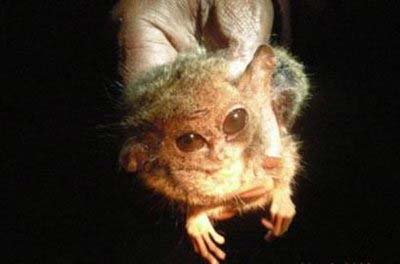
On a misty mountaintop on the Indonesian island of Sulawesi, scientists for the first time in more than eight decades have observed a living pygmy tarsier, one of the planet's smallest and rarest primates.
Over a two-month period, the scientists used nets to trap three furry, mouse-sized pygmy tarsiers -- two males and one female -- on Mt. Rore Katimbo in Lore Lindu National Park in central Sulawesi, the researchers said on Tuesday.
They spotted a fourth one that got away.
The tarsiers, which some scientists believed were extinct, may not have been overly thrilled to be found. One of them chomped Sharon Gursky-Doyen, a Texas A&M University professor of anthropology who took part in the expedition.
"I'm the only person in the world to ever be bitten by a pygmy tarsier," Gursky-Doyen said in a telephone interview.
"My assistant was trying to hold him still while I was attaching a radio collar around its neck. It's very hard to hold them because they can turn their heads around 180 degrees. As I'm trying to close the radio collar, he turned his head and nipped my finger. And I yanked it and I was bleeding.
The collars were being attached so the tarsiers' movements could be tracked.
Tarsiers are unusual primates -- the mammalian group that includes lemurs, monkeys, apes and people. The handful of tarsier species live on various Asian islands.
As their name indicates, pygmy tarsiers are small -- weighing about 2 ounces (50 grammes). They have large eyes and large ears, and they have been described as looking a bit like one of the creatures in the 1984 Hollywood movie "Gremlins."
They are nocturnal insectivores and are unusual among primates in that they have claws rather than finger nails.
They had not been seen alive by scientists since 1921. In 2000, Indonesian scientists who were trapping rats in the Sulawesi highlands accidentally trapped and killed a pygmy tarsier.
"Until that time, everyone really didn't believe that they existed because people had been going out looking for them for decades and nobody had seen them or heard them," Gursky-Doyen said.
Her group observed the first live pygmy tarsier in August at an elevation of about 6,900 feet.
"Everything was covered in moss and the clouds are right at the top of that mountain. It's always very, very foggy, very, very dense. It's cold up there. When you're one degree from the equator, you expect to be hot. You don't expect to be shivering most of the time. That's what we were doing," she said.
Source: Yahoo news


